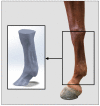Measuring Volumetric Changes of Equine Distal Limbs: A Pilot Study Examining Jumping Exercise
- PMID: 31575002
- PMCID: PMC6826953
- DOI: 10.3390/ani9100751
Measuring Volumetric Changes of Equine Distal Limbs: A Pilot Study Examining Jumping Exercise
Abstract
Equine athletes can incur musculoskeletal injuries due to repetitive loading during training and competition. Prior to signs of lameness, horse trainers and veterinarians may observe swelling in the distal limbs, where injuries most frequently occur. Early observations may guide modulation of training to manage physiological stress and mitigate risk of injury. However, these observations of changing limb volume can be subjective and imprecise. The aim of this study was to assess the accuracy and applicability of a tablet-mounted, 3D scanner to measure and record distal limb volumes of horses before and after exercise. Users recorded scans of a cylinder of known volume with errors up to 8%. Experienced users' measures were biased (i.e., consistently overestimated). The scanner was able to detect statistically significant increases in volume for both fore and hind limbs after one jumping session (310-2058 cm3). Age and intensity of workload may play a role in magnitude of limb swelling, but had mixed conclusions between fore and hind limbs. More studies with additional horses must be performed to solidify these relationships. The evaluated 3D scanner is a low-cost, accessible tool that was able to detect changes in limb swelling as a result of exercise and mechanical stress. With continued research, this information may guide training programs to decrease injury and maximize performance of equine athletes in the future.
Keywords: 3D scanning; exercise; horse; inflammation; jumping; swelling.
Conflict of interest statement
The authors declare no conflict of interest. The funders had no role in the design of the study; in the collection, analyses, or interpretation of data; in the writing of the manuscript, or in the decision to publish the results.
Figures


Similar articles
-
Comparison of a body-mounted inertial sensor system-based method with subjective evaluation for detection of lameness in horses.Am J Vet Res. 2013 Jan;74(1):17-24. doi: 10.2460/ajvr.74.1.17. Am J Vet Res. 2013. PMID: 23270341
-
Relationships between morphometric measurements and musculoskeletal disorders in jumping Thoroughbred horses.J Equine Sci. 2020 Jun;31(2):23-27. doi: 10.1294/jes.31.23. Epub 2020 Jun 24. J Equine Sci. 2020. PMID: 32617072 Free PMC article.
-
Kinematic differences between the distal portions of the forelimbs and hind limbs of horses at the trot.Am J Vet Res. 1995 Nov;56(11):1522-8. Am J Vet Res. 1995. PMID: 8585667
-
Proactive Management of the Equine Athlete.Animals (Basel). 2012 Dec 19;2(4):640-55. doi: 10.3390/ani2040640. Animals (Basel). 2012. PMID: 26487168 Free PMC article. Review.
-
The role of scintigraphy in the lameness evaluation.Vet Clin North Am Equine Pract. 1991 Aug;7(2):207-39. doi: 10.1016/s0749-0739(17)30498-4. Vet Clin North Am Equine Pract. 1991. PMID: 1933561 Review.
References
-
- Crevier-Denoix N., Pourcelot P., Ravary B., Robin D., Falala S., Uzel S., Grison A.C., Valette J.P., Denoix J.M., Chateau H. Influence of track surface on the equine superficial digital flexor tendon loading in two horses at high speed trot. Equine Vet. J. 2009;41:257–261. doi: 10.2746/042516409X394445. - DOI - PubMed
Grants and funding
LinkOut - more resources
Full Text Sources

